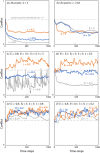Stochastic events can explain sustained clustering and polarisation of opinions in social networks
- PMID: 33446774
- PMCID: PMC7809277
- DOI: 10.1038/s41598-020-80353-7
Stochastic events can explain sustained clustering and polarisation of opinions in social networks
Abstract
Understanding the processes underlying development and persistence of polarised opinions has been one of the key challenges in social networks for more than two decades. While plausible mechanisms have been suggested, they assume quite specialised interactions between individuals or groups that may only be relevant in particular contexts. We propose that a more broadly relevant explanation might be associated with the influence of external events. An agent-based bounded-confidence model has been used to demonstrate persistent polarisation of opinions within populations exposed to stochastic events (of positive and negative influence) even when all interactions between individuals are noisy and assimilative. Events can have a large impact on the distribution of opinions because their influence acts synchronistically across a large proportion of the population, whereas an individual can only interact with small numbers of other individuals at any particular time.
Conflict of interest statement
The authors declare no competing interests.
Figures




References
-
- McPherson M, Smith-Lovin L, Cook JM. Birds of a feather: Homophily in social networks. Annu. Rev. Sociol. 2001;27:415–444. doi: 10.1146/annurev.soc.27.1.415. - DOI
-
- Axelrod R. The dissemination of culture—A model with local convergence and global polarization. J. Conflict Resolut. 1997;41:203–226. doi: 10.1177/0022002797041002001. - DOI
-
- Hegselmann, R. & Krause, U. Opinion dynamics and bounded confidence: Models, analysis and simulation. Jasss J. Artif. Soc. S5(3), 2. http://jasss.soc.surrey.ac.uk/5/3/2.html (2002).
-
- Lorenz J. Continuous opinion dynamics under bounded confidence: A survey. Int. J. Mod. Phys. C. 2007;18:1819–1838. doi: 10.1142/S0129183107011789. - DOI
Publication types
LinkOut - more resources
Full Text Sources
Other Literature Sources

